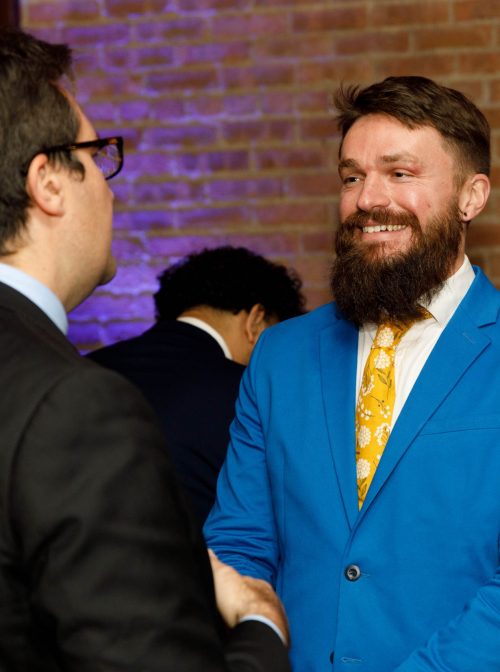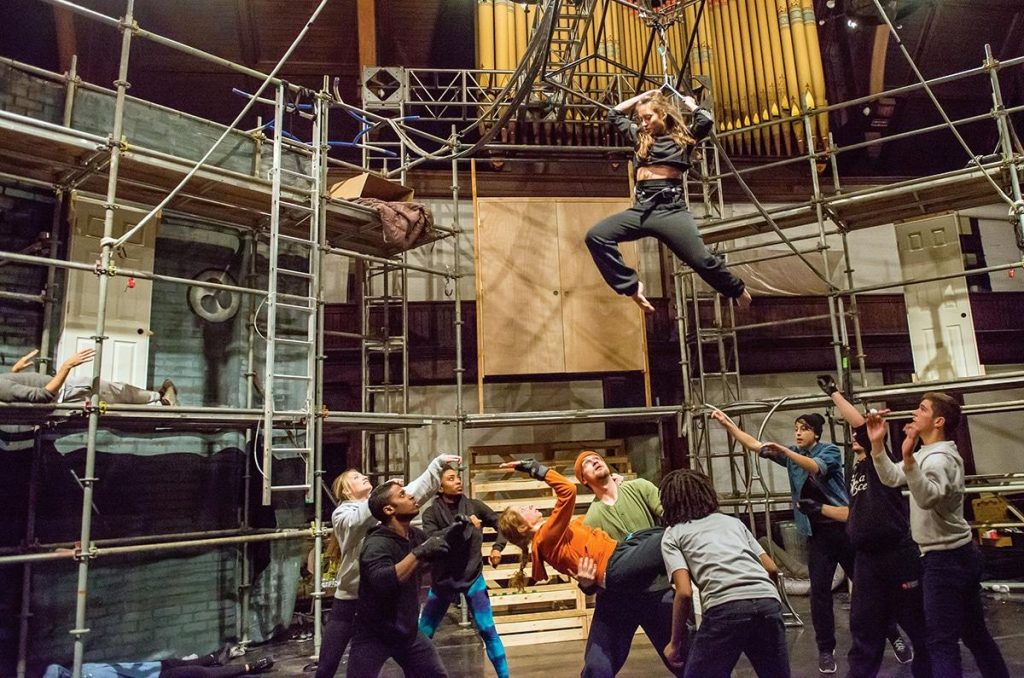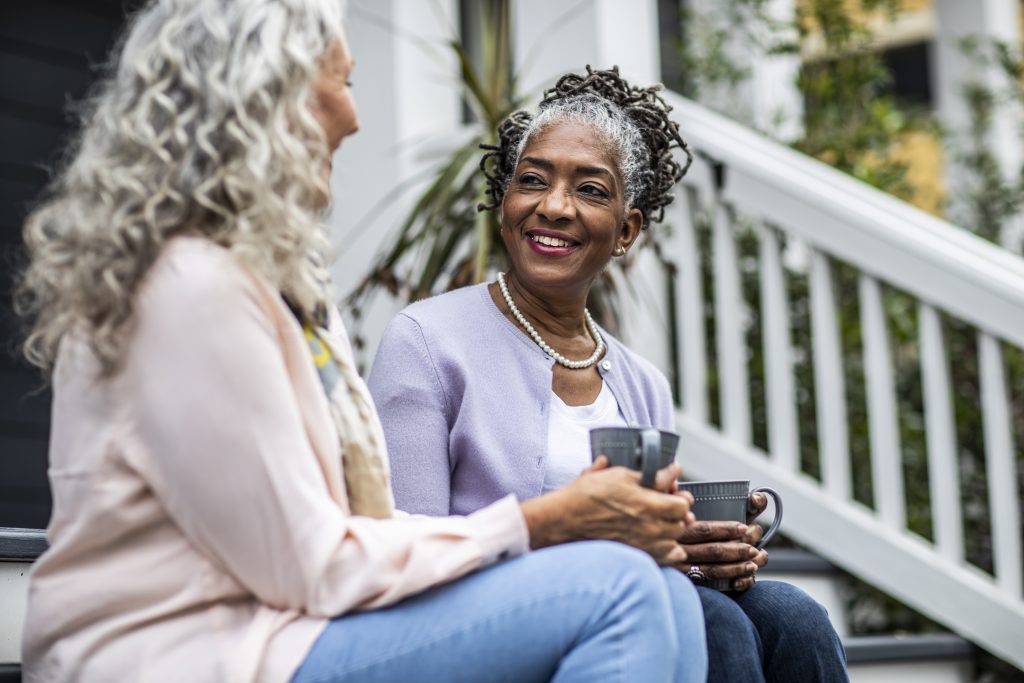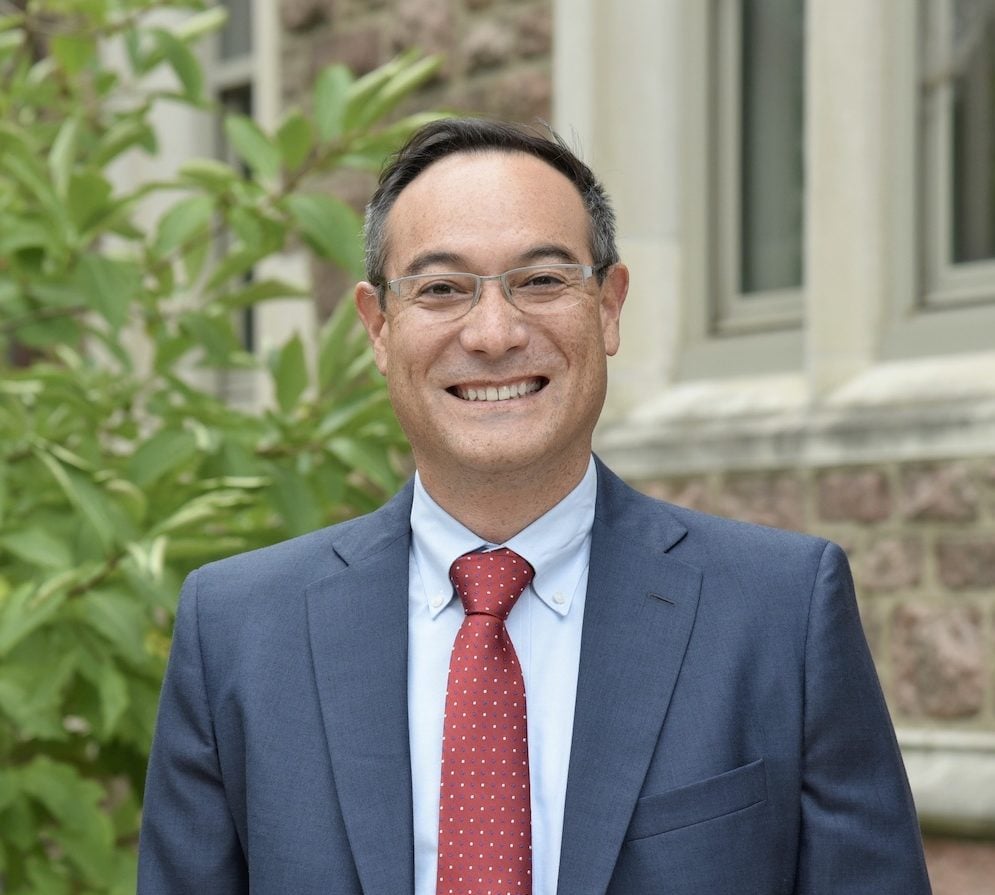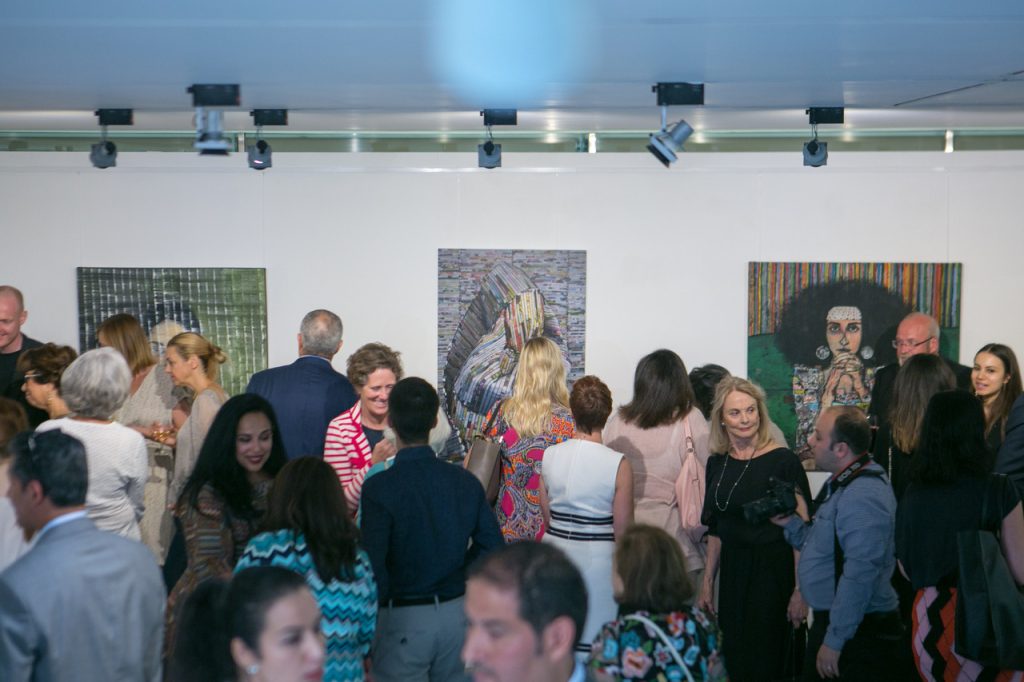To celebrate the 20th anniversary of Interfaith America, we spoke with individuals connected to the organization about their own interfaith work, favorite memories of IFYC/Interfaith America, and their hopes for the future of this important work.
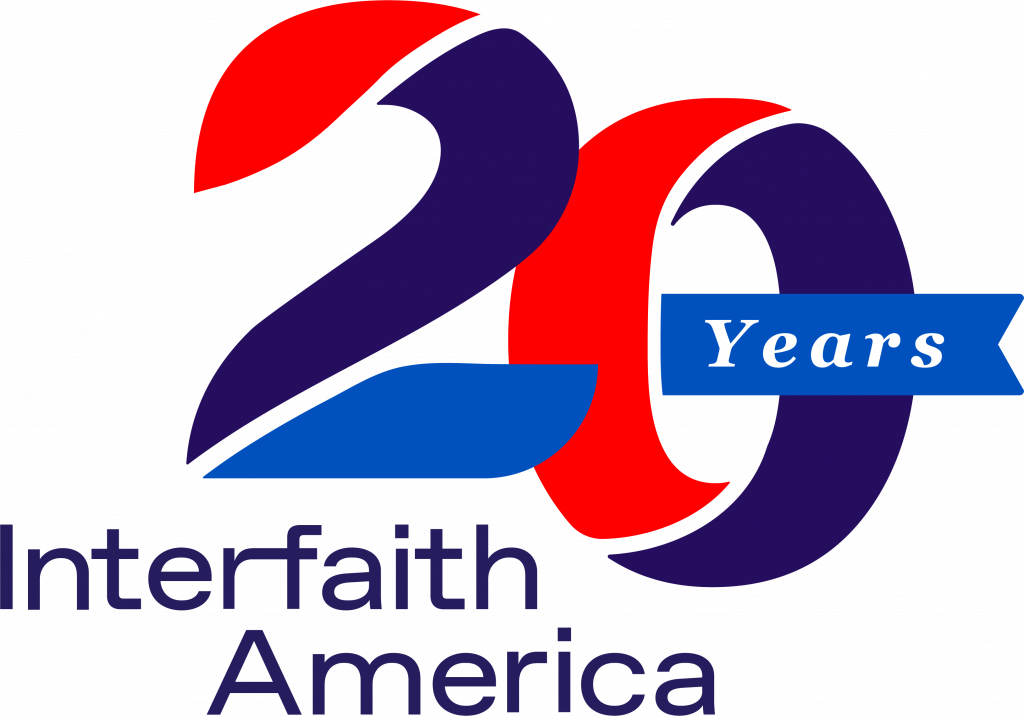
We spoke with Chris Stedman, a professor in the Department of Religion and Philosophy at Augsburg University in Minneapolis and author of the books “Faitheist” and “IRL,” about his interfaith advocacy and how he came to interfaith spaces.
This conversation was edited for length and clarity.
Allie Vroegop: What’s your connection to interfaith work and Interfaith America?
Chris Stedman: I tell a good amount of the story of how I first got involved in interfaith work in “Faitheist,” which turns 10 [in November]. I grew up nonreligious, but became a Christian as an adolescent while I was looking for a sense of community and a place to explore questions of meaning. Eventually, I decided to go to college to continue studying religion. While studying religion in college, I realized that I wasn’t actually religious. I went full circle from not religious to religious and back to not religious. Along the way, I experienced religious communities at their best and also at their most closed and insular. As a result, my relationship with religion felt pretty fraught. I knew I was still interested in it, but I didn’t know quite what to do with that interest. Eventually, I decided to go back to school to do a master’s in religion. I was taking classes at all these different theological schools [through the Chicago theological consortium], trying to get a better understanding of how religious communities help people wrestle with questions of meaning and purpose, as someone who’s not religious and who thinks that even when a person decides they’re no longer religious, or who wasn’t raised religious, that doesn’t necessarily mean they don’t have the same foundational need for a sense of meaning and belonging. I was trying to get a better understanding of how nonreligious people could meet those needs. At the same time, I wanted a better understanding of how nonreligious people should relate to religious people.
I came to encounter the work of Interfaith America [then Interfaith Youth Core]. I read Eboo Patel’s book, “Acts of Faith” and, when I went to Chicago, I knew I wanted to work with this organization in some way. In 2009 I reached out to the organization, came in for a meeting and a tour, and learned of different ways to get involved. I learned that there was an internship program and ultimately became an intern. Then, when my internship ended, one of the big projects I was working on was Leadership for a Religiously Diverse World, a big conference IA held. There was still a lot to do for the conference, which was a couple months off at that point, so I ended up staying on as contract staff. After that, I stayed on as a content developer and adjunct trainer. I also worked with some IA staff members on re-envisioning some of the trainings that were happening at the time.
It was actually at IA where I first encountered humanism. It was Eboo said, “You know, I hear you describing yourself as an atheist as a non-religious person “— that was a big focus of the work I was doing in IA trying to find ways to bring more nonreligious people into the conversation. He said, “I’m glad that you’re here. I think it’s important, but also, when I hear you talk about the things you do believe I hear a lot of humanism in that, but I’ve never heard you use that language. And I’m curious if it resonates with you?” I hadn’t heard of it, so he pointed me in the direction of humanist communities, humanist resources, and I found in humanism some language to express the values I do have as a non-religious person and a non-theist.
When I finished my master’s, I went out to work for the humanist chaplaincy at Harvard and then at Yale, and I was there for four years each. Along the way, IA continued to be hugely supportive of what I was doing. When “Faitheist” came out in 2012, Eboo wrote the foreword for it, and Amber Hacker wrote a resource to go along with it to help communities that wanted to explore how nonreligious people can be a part of interfaith conversations and interfaith work.
AV: What’s a special memory that you have, either of your time working at IA or your interactions with them?
CS: Over the last 10 years since “Faitheist” came out, I’ve traveled the country and the world speaking and writing, and I don’t think I would have been able to do any of that without the formative experiences I had at IA. I really learned how to tell my story, how to speak in front of a group of people. I remember one of my first real public speaking engagements was at Leadership for Religiously Diverse World, because IA staff member Cassie Meyer asked if I would offer some words from a humanist perspective. It made me feel like my voice was valued, and I had something I could contribute.
I think some people naturally come alive in front of an audience. I’m not one of those people. But IA really helped me find my voice, see the value in what I had to say, and recognize the importance of telling a different story about atheism and what it means to be an atheist. A lot of the skills that I now have, that I didn’t have back then, I can definitely trace to my experiences at IA.
The other thing that came to mind, when “Faithiest” was done and getting ready to go to press, my publisher said, “Do you have a headshot?” I was 23 or 24; I definitely didn’t have a headshot, a nd I certainly couldn’t afford to pay a photographer. I reached out to Amber at IA and said, “I don’t know what to do. They need a headshot to go in the book.” Amber helped me figure it out. IA ended up creating this alumni fund, which became this huge program for supporting IA alums [now Emerging Leaders]. And it all grew out of me reaching out to Amber. I’ve always felt that I could reach out [and ask IA for help.] Or that if there’s a question I’m trying to think about, or resources I’m looking for, I’ve always felt like it was an open door.
AV: What’s something that you’re really proud of in your time with IA or something that IA has achieved in the past 20 years?
CS: One thing I’m really proud of is that when I was first getting involved in IA’s work, there were definitely other atheists and humanists there, but not like there are today. One thing that’s been really fun to see over the last 10 plus years has been just how much that has shifted, and how Interfaith America now has all these relationships with different atheist and secular organizations, like the Secular Student Alliance. Given America’s changing religious landscape, and how the religiously unaffiliated are the fastest growing segment of the religious landscape in this country, I think it’s more important than ever that the nonreligious are included in interfaith work. And I think IA has really been at the cutting edge of expanding interfaith beyond people who identify in normative ways religiously, to include people who are not only atheist, agnostic, or humanist, but also people who are not sure, or who are seeking or spiritual, but not religious. That’s a big shift I’ve noticed, and I think it’s something that a lot of people inside and outside of IA contributed to. That’s one thing that is both a special memory and something that I’m proud of, and that I think the organization has really been on the cutting edge of.
When I first was getting involved in interfaith work, people would sometimes ask, “Why are you here?” Now, people don’t ask that question at all. I think a lot of that is because of the work that IA has done to specifically highlight and call out the nonreligious as being important stakeholders in this work. They were absolutely ahead of the curve in that respect.
AV: How has Interfaith America impacted your work that you’re doing out in the world?
CS: I learned how to find my voice and see the value in my story through my work with Interfaith America. I think I once thought that I didn’t necessarily have something to offer. But I learned in interfaith spaces that we need lots of different voices. And not just in terms of worldviews. Not only do we need humanist voices in interfaith, we also need different voices that tell the story of pluralism in different ways. And it made me feel like my own particular way of doing so had value.
Even through my work today, I teach religion, and obviously draw a lot on my experiences with IA in that work. Even though my writing has sort of moved a bit away from interfaith as a primary focus—like my last book and my podcast that I released in 2020, neither of them really have overtly much to do with interfaith— but I think that the formative experiences I had in interfaith work and working with IA instilled in me a kind of curiosity about the lives of others, and an interest in looking beyond the surface level to what motivates people to move through the world in the way that they do, to be curious, to not make assumptions. And I think that definitely continues to shape my work as a writer.
If I were to identify a single thread or throughline in my work and my various writing projects over the years, it is a curiosity about the stories we tell ourselves about who we are and the stories that we tell ourselves about who other people are. And, again, I think so much of the way I approach that has been shaped by the value that IA puts on approaching these kinds of conversations and approaching difference with curiosity, rather than seeing it as a threat or something to be scared of.
AV: Where do you envision the future for Interfaith America as an organization or hope for where the interfaith space would be?
CS: When I think about the future of Interfaith America, I think about the future of religion in this country. We’re in this very transitional moment when it comes to religion, where a lot of people are leaving religious institutions. They’re not ceasing to wrestle with the questions of religion—for example, the majority of people who say that they’re not religious do say they believe in a God or a higher power, or engage regularly in practices like prayer—but what it means to be religious or to not religious is going through this huge transformation.
There are people who are responding to that with fear. And I think that’s why we’re seeing, for example, a rise in Christian nationalism. Because I think that people who have been accustomed to Christians holding a certain place in the culture, having a sort of dominant position, see that religion is changing and some people are becoming less religious, and they’re reacting to that with fear. I think that interfaith organizations, like Interfaith America, have a really critical role to play in helping change the narrative around what this religious transition means for our country and for our world. To invite people to respond to this change from a place of curiosity, rather than a place of fear. My hope for the future of the organization is to be a voice that can help people think not only about their fears when it comes to how the religious landscape is changing, but also to see in it the potential for rewriting our story, collectively, in a way that makes all of our lives richer.
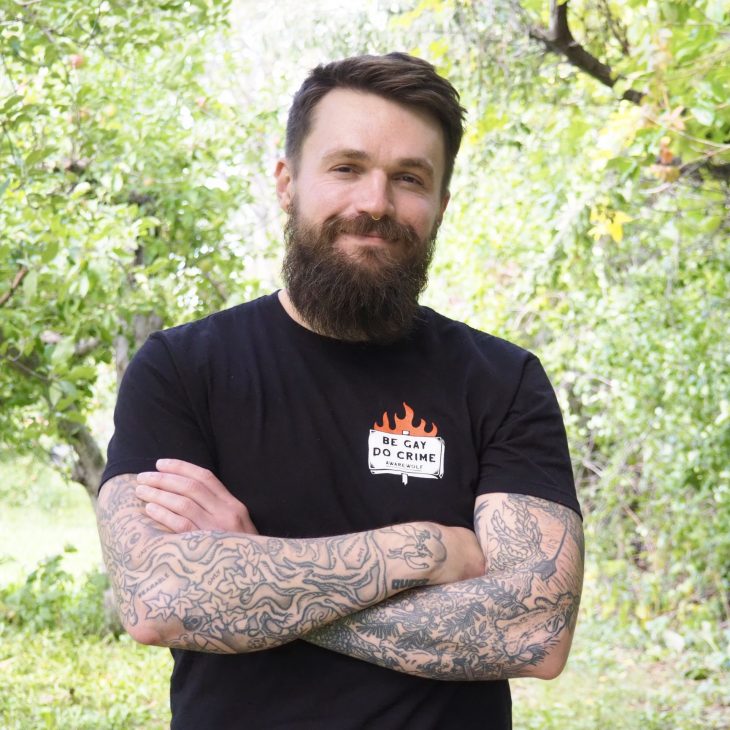
Chris Stedman
Chris Stedman is a writer, activist, and professor who teaches in the Department of Religion and Philosophy at Augsburg University in Minneapolis, Minnesota. He is the author of IRL: Finding Our Real Selves in a Digital World and Faitheist: How an Atheist Found Common Ground with the Religious, as well as the writer and host of Unread, named one of the best podcasts of 2021 by the Guardian, Vulture, HuffPost, Mashable, and the CBC, and honored by the 2022 Webby Awards. Additionally, Stedman has written popular essays for outlets including the Atlantic, Pitchfork, BuzzFeed, VICE, and the Washington Post. Previously the founding director of the Yale Humanist Community and a fellow at Yale University, he also served as a humanist chaplain at Harvard University and a content developer and trainer for Interfaith America (formerly Interfaith Youth Core).
